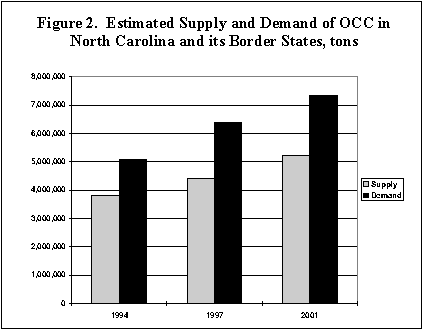

Old corrugated containers (OCC) are utilized as a feedstock for a wide variety of products in the paper industry. The following North Carolina companies produce products containing OCC such as containerboard, paperboard, roofing felt, tissue, and molded pulp.
- Weyerhaeuser Paper Company, Plymouth, makes recycled-content linerboard and medium.
- Jackson Paper Manufacturing Company, Sylva, makes a 100-percent recycled-content linerboard.
- Carolina Paper Board Corporation, Charlotte, makes a 100-percent recycled paper board that contains approximately 25 percent OCC.
- The Celotex Corporation, Goldsboro, uses OCC in the manufacture of roofing felt.
- Cascades Molded Pulp, Rockingham, produces 100-percent recycled-content molded beverage trays using a mix of OCC and old newsprint.
In recent years OCC has been one of the most common commodities that recycling programs and businesses collect. In early 1995, prices for OCC peaked at over $200 per ton. Factors such as a robust economy and strong exports contributed to these record prices, and the fluctuation of these factors in particular determines the level of OCC prices. It should also be noted the price of OCC determines the level of OCC utilized in manufacturing processes. For example, if a paperboard company uses OCC as 50 percent of its feedstock when prices are low, it will seek less expensive alternatives such as mixed paper when OCC prices are high.
| In its 1994 update of the municipal waste stream (MWS), the Environmental Protection Agency (EPA) estimated the amount of corrugated containers generated in the U.S. in 1990 through 1993 and 2000. The report determined that by the year 2000, OCC generation will reach 31 million tons nationwide. Figure 1 shows generation estimates for North Carolina and its border states for 1994 through 2001. These estimates were developed by prorating U.S. estimates by population. |  |
The 1994 EPA report estimates that OCC recovery was at 13.32 million tons in 1993 and will be at 19.84 million tons by 2000. Those estimates are based on recovery rates of 55.5 percent and 64 percent, respectively. These figures are used to extrapolate OCC recovery estimates for North Carolina and the Southeast region.
Specific information on OCC recovered regionally from the North Carolina waste stream is available from local government reports. Because a substantial amount of OCC is recovered from the North Carolina MSW through private sector recycling programs, local government figures underestimate the amount of OCC recovered from the state's MSW. The North Carolina Division of Pollution Prevention and Environmental Assistance estimates OCC recovery in 1995 at 460,000 tons, or a recovery rate of 65 percent.
Containerboard and paperboard mills in the Southeast provide steady OCC markets. OCC capacity at these mills is currently over 5.5 million tons per year. Several factors such as increased costs for virgin feedstocks and increased consumer demand for recycled content account for the increased utilization of OCC in the region.
End Use |
1994, tons |
1997, tons |
2001, tons |
Annual Increase, % |
Containerboard |
3,501,100 |
4,789,100 |
5,610,100 |
5.9 |
Paperboard |
1,369,900 |
1,379,100 |
1,532,500 |
2.8 |
Roofing Material |
195,800 |
195,800 |
195,800 |
0 |
Tissue |
1,100 |
1,700 |
2,500 |
19.4 |
Molded Paper Products |
1,000 |
1,000 |
1,000 |
0 |
Total |
5,068,900 |
6,366,700 |
7,341,900 |
| Figure 2 outlines the estimated supply and demand relationship for OCC in North Carolina and its border states. |  |
Even with prices in recent years ranging from over $200 per ton down to $40 per ton, OCC is one of the most stable recyclable commodities in North Carolina. The abundance of end-use markets in the Southeast guarantees that for the foreseeable future, demand will exceed supply in the region. As with other commodities, OCC is affected by economic factors such as manufacturing activity and overseas market conditions. Local governments, businesses, and other collectors should make OCC a cornerstone of any recycling program they undertake.